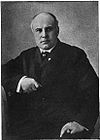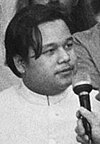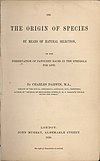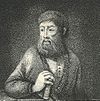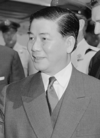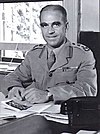Wikipedia:Today's featured article/November 2009
| << | Today's featured articles for November 2009 | >> | ||||
|---|---|---|---|---|---|---|
| Su | Mo | Tu | We | Th | Fr | Sa |
| 1 | 2 | 3 | 4 | 5 | 6 | 7 |
| 8 | 9 | 10 | 11 | 12 | 13 | 14 |
| 15 | 16 | 17 | 18 | 19 | 20 | 21 |
| 22 | 23 | 24 | 25 | 26 | 27 | 28 |
| 29 | 30 | |||||
November 1
Jacques Plante (1929–1986) was a Canadian professional ice hockey goaltender. He won the Stanley Cup six times as a member of the National Hockey League's (NHL) Montreal Canadiens from 1953 to 1963, including five times in consecutive seasons. He first retired in 1965, but returned to play for St. Louis Blues, Toronto Maple Leafs and Boston Bruins of the NHL. In 1973, he joined the World Hockey Association (WHA), first as coach and general manager of the Quebec Nordiques, then goaltender for the Edmonton Oilers. He finally retired from professional play in 1975. Plante is one of the most important ice hockey innovators. His most recognizable contribution is the first practical goaltender mask, which he debuted during a November 1, 1959 game. While Plante had worn a mask in practice for some time before, during the game his nose was broken by a shot. Since he was the only available goaltender, his coach (who was adamantly opposed to goaltenders wearing masks) caved in to Plante's insistence on wearing it in an actual game. Plante was the first goaltender to regularly play the puck outside of his crease. He further aided his fellow players by shouting directions to them; as the goaltender, he had the best view of the game. Plante was inducted into the Hockey Hall of Fame in 1978. (more...)
Recently featured: Manchester Mummy – Cosmo Gordon Lang – Mutual Broadcasting System
November 2
Rufus Wilmot Griswold (1815–1857) was an American anthologist, editor, poet, and critic. Born in Vermont, he worked as a journalist, editor, and critic in Philadelphia, New York City, and elsewhere. He built up a strong literary reputation, in part due to his 1842 collection The Poets and Poetry of America. This anthology, the most comprehensive of its time, included what he deemed the best examples of American poetry. He produced revised versions and similar anthologies for the remainder of his life, although many of the poets he promoted have since faded into obscurity. Many writers hoped to have their work included in one of these editions, although they commented harshly on Griswold's abrasive character. Edgar Allan Poe, whose poetry had been included in Griswold's anthology, published a critical response that questioned which poets were included. This began a rivalry which grew when Griswold succeeded Poe as editor of Graham's Magazine at a higher salary than Poe's. Griswold considered himself an expert in American poetry and was an early proponent of its inclusion on the school curriculum. He also supported the introduction of copyright legislation, speaking to Congress on behalf of the publishing industry, although he was not above pirating other people's work. (more...)
Recently featured: Jacques Plante – Manchester Mummy – Cosmo Gordon Lang
November 3
Gray's Inn is one of the four Inns of Court in London. To be called to the Bar and practise as a barrister in England and Wales, an individual must belong to one of these Inns. Located at the intersection of High Holborn and Gray's Inn Road, the Inn is both a professional body and a place of living and office accommodation (chambers) for many barristers. It is ruled by a governing council called "Pension", made up of the Masters of the Bench (or "Benchers"), and led by the Treasurer, who is elected to serve a one-year term. The Inn is known for its gardens, or Walks, which have existed since at least 1597. Gray's Inn does not claim a specific foundation date; there is a tradition that none of the Inns of Court claims to be any older than the others. Law clerks and their apprentices have been established on the present site since at least 1370, with records dating from 1391. During the 15th and 16th centuries, the Inn grew steadily, reaching its pinnacle during the reign of Elizabeth I. The outbreak of the First English Civil War in 1642 during the reign of Charles I disrupted the systems of legal education and governance at the Inns of Court, shutting down all calls to the Bar and new admissions, and Gray's Inn never fully recovered. Fortunes continued to decline after the English Restoration, which saw the end of the traditional method of legal education. Although now more prosperous, Gray's Inn is still the smallest of the Inns of Court. (more...)
Recently featured: Rufus Wilmot Griswold – Jacques Plante – Manchester Mummy
November 4
Interstate 355 is an Interstate Highway and tollway in the western and southwest suburbs of Chicago, Illinois, U.S. Like most other tollways in the northeastern portion of the state, I-355 is maintained by the Illinois State Toll Highway Authority. I-355 runs from Interstate 80 in New Lenox north to Interstate 290 in Itasca, a distance of 32.5 miles (52.3 km). The tollway authority opened I-355 as the North–South Tollway in 1989 to ease congestion on Illinois Route 53 (IL 53), a parallel two-lane state highway in central DuPage County. Initially, I-355 ran from Interstate 55 north to I-290. The new highway helped cut travel times for commuters traveling north and south in the county. According to commercial real estate developers at the time, the new tollway also opened the western suburbs of Chicago to commercial and industrial development. On November 11, 2007, the tollway authority opened a southern extension of I-355 from I-55 to I-80, a distance of 12.5 miles (20.1 km); on its opening, the tollway authority changed the name of the tollway to "Veterans Memorial Tollway". The tollway authority laid the route of the new extension through Will County and a small portion of Cook County, one of the fastest-growing regions in Illinois. The tollway authority expects the extension to cut travel times in the region by 20 percent. (more...)
Recently featured: Gray's Inn – Rufus Wilmot Griswold – Jacques Plante
November 5
Franklin Knight Lane (1864–1921) was an American Democratic politician from California who served as United States Secretary of the Interior from 1913 to 1920. He also served as a commissioner of the Interstate Commerce Commission, and was the Democratic nominee for governor of California in 1902, losing a narrow race in what was then a heavily Republican state. Lane was born July 15, 1864, near Charlottetown, Prince Edward Island, in what was then a British colony but is now part of Canada, and in 1871, his family moved to California. Elected City Attorney of San Francisco in 1898, a post he held for five years, Lane ran in 1902 for governor and in 1903 for mayor of San Francisco, losing both races. In 1903, he received the support of the Democratic minority in the California State Legislature during the legislature's vote to elect a United States Senator from California. It was often said of Lane that had he not been born in what is now Canada, he would have become president. In spite of that limitation, Lane was offered support for the Democratic nomination for Vice President, though he was constitutionally ineligible for that office as well. (more...)
Recently featured: Interstate 355 – Gray's Inn – Rufus Wilmot Griswold
November 6
Darjeeling is a town in the Indian state of West Bengal. It is the headquarters of Darjeeling district, in the Shiwalik Hills on the lower range of the Himalaya, at an average elevation of 6,982 ft (2,128 m). During the British Raj in India, Darjeeling's temperate climate led to its development as a hill station for British residents to escape the heat of the plains during the summers. Darjeeling is internationally famous for its tea industry and the Darjeeling Himalayan Railway, a UNESCO World Heritage Site. The tea growers of the area developed distinctive hybrids of black tea and fermenting techniques, with many blends considered among the world's finest. The Darjeeling Himalayan Railway connecting the town with the plains was declared a World Heritage Site in 1999 and has one of the few steam locomotives still in service in India. Darjeeling has several British-style public schools, which attract students from many parts of India and neighbouring countries. The town, along with neighbouring Kalimpong, was a major center for the demand of a separate Gorkhaland state in the 1980s, though the separatist movement has gradually decreased over the past decade due to the setting up of an autonomous hill council. In recent years the town's fragile ecology is threatened by a rising demand for environmental resources, stemming from growing tourist traffic and poorly planned urbanisation. (more...)
Recently featured: Franklin Knight Lane – Interstate 355 – Gray's Inn
November 7
The Victoria Cross for Australia is the highest award in the Australian Honours System, superseding the Victoria Cross for issue to Australians. It was created by letters patent signed by Elizabeth II, Queen of Australia, on 15 January 1991. The first medal was awarded on 16 January 2009 to Trooper Mark Donaldson, for the rescue of a coalition forces interpreter from heavy fire in Oruzgan Province in Afghanistan. Donaldson's award came almost 40 years after Warrant Officer Keith Payne became the last Australian to be awarded the (original) Victoria Cross for gallantry on 24 May 1969 during the Vietnam War. The Victoria Cross for Australia is the "decoration for according recognition to persons who in the presence of the enemy, perform acts of the most conspicuous gallantry, or daring or pre-eminent acts of valour or self-sacrifice or display extreme devotion to duty." As the highest Australian award, it is listed first on the Australian Order of Wear with precedence in Australia over all orders, decorations and medals. The decoration may be awarded to members of the Australian Defence Force and to other persons determined by the Australian Minister for Defence. When the medal is awarded, the ceremony is presided over by the Governor-General of Australia on behalf of the Queen of Australia, who presents the medal during an investiture. (more...)
Recently featured: Darjeeling – Franklin Knight Lane – Interstate 355
November 8
The 1968 Illinois earthquake was the largest recorded earthquake in the state of Illinois, measuring 5.4 on the Richter scale. Although there were no fatalities, the earthquake caused considerable structural damage to buildings, including the toppling of chimneys. The earthquake was one of the most widely felt in U.S. history, affecting 23 states over an area of 580,000 square miles (1,500,000 km2). In studying its cause, scientists discovered the Cottage Grove Fault in the Southern Illinois Basin. Within the region, millions felt the rupture. Reactions to the earthquake varied: some people near the epicenter did not react to the shaking, while others panicked. A future earthquake in the region is extremely likely; seismologists and geologists estimate a 90% chance of a magnitude 6–7 tremor before 2055, likely originating in the Wabash Valley seismic zone on the Illinois–Indiana border, or the New Madrid fault zone. The first record of seismic activity in Illinois is from 1795, when a small earthquake shook the frontier settlement of Kaskaskia. Data from large earthquakes—in May and July 1909, and November 1968—suggest that earthquakes in the area are of moderate magnitude but can be felt over a large geographical area. (more...)
Recently featured: Victoria Cross for Australia – Darjeeling – Franklin Knight Lane
November 9
The inner German border was the frontier between the German Democratic Republic (East Germany) and the Federal Republic of Germany (West Germany) from 1949 to 1990. Not including the similar but physically separate Berlin Wall, the border was 1,381 kilometres (858 mi) long and ran from the Baltic Sea to Czechoslovakia. It was formally established on 1 July 1945 as the boundary between the Western and Soviet occupation zones of Germany. On the Eastern side, it was made one of the world's most heavily fortified frontiers, defined by a continuous line of high metal fences and walls, barbed wire, alarms, trenches, watchtowers, automatic booby-traps and minefields. The border was a physical manifestation of Winston Churchill's metaphor of an Iron Curtain separating the Soviet and Western blocs during the Cold War. Built by East Germany in phases from 1952 to the late 1980s, the fortifications were constructed to stop the large-scale emigration of East German citizens to the West. It caused widespread economic and social disruption on both sides. On 9 November 1989, the East German government announced the opening of the Berlin Wall and the inner German border. The inner German border was not completely abandoned until 1 July 1990, exactly 45 years to the day since its establishment, and only three months before German reunification formally ended Germany's division. Little remains today of the inner German border's fortifications. (more...)
Recently featured: 1968 Illinois earthquake – Victoria Cross for Australia – Darjeeling
November 10
Millennium '73 was a free three-day festival held in November 1973 at the Astrodome in Houston, Texas by the Divine Light Mission. It featured Prem Rawat, then known as Guru Maharaj Ji, a 15-year-old guru and the leader of a fast-growing Western religious movement. Organizers billed the festival as the most significant event in human history which would usher in a thousand years of peace. The festival's official schedule described the three evening addresses by Guru Maharaj Ji as the highlights of the event. Big-band music, rock bands, religious songs, choral works, a dance performance and speeches by other DLM leaders filled the program from noon to 10 pm. Media events included press conferences and an impromptu debate. Millennium '73 received wide publicity. Rennie Davis, a prominent anti-war activist and member of the Chicago Seven, helped draw attention to the event as a spokesman for the DLM. Notable journalists attended, some of them acquaintances of Davis from the New Left. It was later described by scholars and journalists as among the major events of 1973 and the 1970s, the high point of Guru Maharaj Ji's popularity, and the most important development in the American DLM's history. Attendance was estimated from 10,000 to 35,000, compared to the projected 100,000. Scholars and journalists generally depicted the event as a disappointment. That, along with other factors including a large debt, led to changes in the DLM's structure, management and message. The following year the movement split into branches headed by Maharaj Ji in the West, and his mother and brother Bal Bhagwan Ji in India. (more...)
Recently featured: Inner German border – 1968 Illinois earthquake – Victoria Cross for Australia
November 11
The Battle of Arras was a British offensive during World War I. From 9 April to 16 May, 1917, British, Canadian, and Australian troops attacked German trenches near the French city of Arras on the Western Front. The Arras offensive was conceived as part of a plan to break through the German defences into the open ground beyond and engage the numerically inferior German army in a war of movement. It was planned in conjunction with the French High Command, who were simultaneously embarking on a massive attack (the Nivelle Offensive) about eighty kilometres to the south. The stated aim of this combined operation was to end the war in forty-eight hours. At Arras, the British Empire's immediate objectives were more modest: (1) to draw German troops away from the ground chosen for the French attack and (2) to take the German-held high ground that dominated the plain of Douai. After considerable bombardment, Canadian troops advancing in the north were able to capture the strategically significant Vimy Ridge. Only in the south, where British and Australian forces were frustrated by the elastic defence, were the attackers held to minimal gains. Although these battles were generally successful in achieving limited aims, many of them resulted in relatively large numbers of casualties. (more...)
Recently featured: Millennium '73 – Inner German border – 1968 Illinois earthquake
November 12
Grim Fandango is a personal computer game in the graphic adventure genre released by LucasArts in 1998 and primarily written by Tim Schafer. It is the first adventure game by LucasArts to use 3D computer graphics overlaid on pre-rendered 2D backgrounds. As with other LucasArts adventure games, the player must converse with other characters and examine, collect, and use objects correctly to solve puzzles in order to progress. Grim Fandango's world combines elements of Aztec beliefs of afterlife with style aspects of film noir, including The Maltese Falcon, On the Waterfront and Casablanca, to create the Land of the Dead, which recently departed souls, represented in the game as calaca-like figures, must travel through before they reach their final destination, the Ninth Underworld. The story follows travel agent Manuel "Manny" Calavera as he attempts to save Mercedes "Meche" Colomar, a newly arrived but virtuous soul, during her long journey. The game received positive reviews, praising its artistic design and overall game direction in particular. Grim Fandango was selected for several gaming awards at the time of release, and is often listed in publishers' lists of top games of all time. However, the game has been considered a commercial failure, which partially led LucasArts to terminate their adventure game development, contributing to the decline of the adventure game genre. (more...)
Recently featured: Battle of Arras – Millennium '73 – Inner German border
November 13
"I Don't Remember" is a song by Australian alternative rock band Powderfinger, from the album Dream Days at the Hotel Existence. It made its radio debut on 9 July 2007 on Australian radio stations, and was subsequently released as a single and digital download on 4 August 2007 in Australia, 3 September 2007 in New Zealand, and 13 August 2007 in the United States. The song was written by Powderfinger lead singer Bernard Fanning, and influenced by bassist John Collins. The riff was then developed by guitarist Ian Haug. The song is about reconciling difficulties and arguments, rather than shifting the blame. "I Don't Remember" was lauded by some reviewers, who appreciated its energy, while other reviewers were more critical, dubbing it an "advertisement song". The music video also received critical acclaim, especially for the parodies it contained. Despite the reviews, the single charted poorly, reaching number 42 on the ARIA Singles Chart. (more...)
Recently featured: Grim Fandango – Battle of Arras – Millennium '73
November 14
William III of England (1650–1702) was the Prince of Orange, Stadtholder of the main provinces of the Dutch Republic, and King of England, Scotland, and Ireland. Born a member of the House of Orange-Nassau, William III won the English, Scottish and Irish crowns following the Glorious Revolution, in which his uncle and father-in-law, James II, was deposed. In England, Scotland and Ireland, William ruled jointly with his wife, Mary II, until her death in 1694. A Protestant, William participated in several wars against the powerful Catholic King Louis XIV of France in coalition with Protestant and Catholic powers in Europe. Many Protestants heralded him as a champion of their faith. Largely due to that reputation, William was able to take the British crowns where many were fearful of a revival of Catholicism under James. William's victory over James II at the Battle of the Boyne in 1690 is commemorated by the Orange Institution in Northern Ireland to this day. His reign marked the beginning of the transition from the personal rule of the Stuarts to the more Parliament-centered rule of the House of Hanover. (more...)
Recently featured: "I Don't Remember" – Grim Fandango – Battle of Arras
November 15
Zelda Fitzgerald (1900–1948) was a novelist and the wife of writer F. Scott Fitzgerald. She was an icon of the 1920s—dubbed by her husband "the first American Flapper". After the success of his first novel This Side of Paradise, the Fitzgeralds became celebrities. The newspapers of New York saw them as embodiments of the Jazz Age and the Roaring Twenties: young, rich, beautiful, and energetic. Following a whirlwind courtship, they married in 1920, and spent the early part of the decade as literary celebrities in New York. Later in the 1920s, they moved to Europe, recast as famous expatriates of the Lost Generation. While Scott received acclaim for The Great Gatsby and his short stories, their marriage was a tangle of jealousy, resentment and acrimony. The strain of her tempestuous marriage, Scott's increasing alcoholism, and her growing instability presaged Zelda's admittance to a sanatorium in 1930. While in a Maryland clinic, she wrote a semi-autobiographical novel, Save Me the Waltz, which was published in 1932. Scott was furious that she had used material from their life together, though he had done the same, such as in Tender Is the Night, published in 1934. Scott died in Hollywood in 1940, having last seen Zelda a year and a half earlier. She spent her remaining years working on a second novel, which she never completed. In 1948, the hospital at which she had been a patient caught fire, causing her death. (more...)
Recently featured: William III of England – "I Don't Remember" – Grim Fandango
November 16
Trial by Jury is a comic opera in one act, with music by Arthur Sullivan and libretto by W. S. Gilbert. It was first produced on 25 March 1875, at London's Royalty Theatre, where it initially ran for 131 performances and was considered a hit, receiving critical praise and outrunning its popular companion piece, Jacques Offenbach's La Périchole. The story concerns a "breach of promise of marriage" lawsuit in which the judge and legal system are the objects of lighthearted satire. Gilbert based the libretto of Trial by Jury on an operetta parody that he had written in 1868. The opera premiered more than three years after Gilbert and Sullivan's only previous collaboration, Thespis. As with most Gilbert and Sullivan operas, the plot of Trial by Jury is ludicrous, but the characters behave as if the events were perfectly reasonable. This narrative technique blunts some of the pointed barbs aimed at hypocrisy, especially of those in authority, and the sometimes base motives of supposedly respectable people and institutions. Critics and audiences praised how well Sullivan's witty and good-humoured music complemented Gilbert's satire. The success of Trial by Jury launched the famous series of 13 collaborative works between Gilbert and Sullivan that came to be known as the Savoy Operas. (more...)
Recently featured: Zelda Fitzgerald – William III of England – "I Don't Remember"
November 17
A fungus is any member of a large group of eukaryotic organisms that includes microorganisms such as yeasts and molds, as well as the more familiar mushrooms. They are classified as a kingdom that is separate from plants, animals and bacteria. One major difference is that fungal cells have cell walls that contain chitin, unlike the cell walls of plants, which contain cellulose. The discipline of biology devoted to the study of fungi is known as mycology, which is often regarded as a branch of botany, even though genetic studies have shown that fungi are more closely related to animals than to plants. Fungi perform an essential role in the decomposition of organic matter and have fundamental roles in nutrient cycling and exchange. They have long been used as a direct source of food, such as mushrooms and truffles, as a leavening agent for bread, and in fermentation of various food products, such as wine, beer, and soy sauce. Since the 1940s, fungi have been used for the production of antibiotics, and, more recently, various enzymes produced by fungi are used industrially and in detergents. (more...)
Recently featured: Trial by Jury – Zelda Fitzgerald – William III of England
November 18
Wind is the flow of air or other gases that compose an atmosphere. On Earth, wind consists of the bulk movement of air. In outer space, solar wind is the movement of gases or charged particles from the sun through space. While wind is often a standalone weather phenomenon, it can also occur as part of a storm system, most notably in a cyclone. Shorter duration winds, such as wind gusts, can cause substantial damage to power lines and suspension bridges. Winds with an intermediate duration, which sharply increase and last for a minute are termed squalls. Long-duration wind speeds have various names associated with their average strength, such as breeze, gale, storm, hurricane, and typhoon. Wind occurs on a range of scales, from local breezes generated by heating of land surfaces and lasting tens of minutes, to global winds resulting from the difference in absorption of solar energy between the climate zones on Earth. The two major driving factors of large scale atmospheric circulation are the differential heating between the equator and the poles, which causes the jet stream and the associated climatological mid-latitude westerlies, polar easterlies, and the trade winds, and the rotation of the planet. In human civilization, wind has inspired mythology, influenced the events of history, expanded the range of transport and warfare, and provided a power source for mechanical work, electricity, and recreation. (more...)
Recently featured: Fungus – Trial by Jury – Zelda Fitzgerald
November 19
Death Valley National Park is a mostly arid United States National Park located east of the Sierra Nevada mountain range in southern Inyo County and northern San Bernardino County in California, with a small extension into southwestern Nye County and extreme southern Esmeralda County in Nevada. The park covers 5,262 square miles (13,630 km2), encompassing Saline Valley, a large part of Panamint Valley, almost all of Death Valley, and parts of several mountain ranges. Death Valley National Monument was proclaimed in 1933, placing the area under federal protection. In 1994, the monument was redesignated a national park, as well as being substantially expanded to include Saline and Eureka Valleys. It is the hottest and driest of the national parks in the United States. It also features the second-lowest point in the Western Hemisphere and the lowest point in North America at Badwater, which is 282 feet (86 m) below sea level. It is home to many species of plants and animals that have adapted to this harsh desert environment. Death Valley National Park is visited annually by more than 770,000 visitors who come to enjoy its diverse geologic features, desert wildlife, historic sites, scenery, clear night skies and the solitude of the extreme desert environment. (more...)
Recently featured: Wind – Fungus – Trial by Jury
November 20
The Han Dynasty was the second imperial dynasty of China, preceded by the Qin Dynasty and succeeded by the Three Kingdoms. Spanning over four centuries, the period of the Han Dynasty is considered a golden age in Chinese history. The Han Empire was divided into areas directly controlled by the central government, known as commanderies, and a number of semi-autonomous kingdoms. The Han Dynasty was an age of economic prosperity, and saw a significant growth of the money economy first established during the Zhou Dynasty. The coinage issued by the central government mint in 119 BCE remained the standard coinage of China until the Tang Dynasty. The emperor was at the pinnacle of Han society. He presided over the Han government, but shared power with both the nobility and appointed ministers who came largely from the scholarly gentry class. From the reign of Emperor Wu onward, the Chinese court officially sponsored Confucianism in education and court politics. Science and technology during Han saw significant advances, including papermaking, the rudder, the use of negative numbers in mathematics, the raised-relief map, the hydraulic-powered armillary sphere for astronomy, and a seismometer employing an inverted pendulum. (more...)
Recently featured: Death Valley National Park – Wind – Fungus
November 21
An electron is a subatomic particle that carries a negative electric charge. It has no known substructure and is believed to be a point particle. An electron has a mass that is approximately 1/1836 that of the proton. The intrinsic angular momentum (spin) of the electron is a half integer value of 1⁄2, which means that it is a fermion. Electrons, which belong to the first generation of the lepton particle family, participate in gravitational, electromagnetic and weak interactions. Electrons have quantum mechanical properties of both a particle and a wave, so they can collide with other particles and be diffracted like light. Since an electron is a fermion, no two electrons can occupy the same quantum state, a property known as the Pauli exclusion principle. The electron was identified as a particle in 1897 by J. J. Thomson and his team of British physicists. In many physical phenomena, such as electricity, magnetism, and thermal conductivity, electrons play an essential role. An electron generates a magnetic field while moving, and it is deflected by external magnetic fields. The exchange or sharing of the electrons between two or more atoms is the main cause of chemical bonding. Electrons may be destroyed through annihilation with positrons, or may be absorbed during nucleosynthesis in stars. Electrons have many applications, including welding, cathode ray tubes, electron microscopes, radiation therapy, lasers and particle accelerators. (more...)
Recently featured: Han Dynasty – Death Valley National Park – Wind
November 22
Werner Mölders (1913–1941) was a German Luftwaffe pilot. He was the leading German fighter ace in the Spanish Civil War; in World War II, he became the first pilot in aviation history to claim 100 aerial victories. The highly decorated Mölders was instrumental in the development of new fighter tactics which led to the finger-four formation. In 1938, he volunteered for service in the Condor Legion, which supported General Francisco Franco's Nationalist Falange in the Spanish Civil War, and shot down 15 aircraft. In World War II, he claimed 101 aerial victories for which he received the Knight's Cross of the Iron Cross with Oak Leaves, Swords and Diamonds. Banned from flying further combat missions Mölders was promoted to Oberst, and appointed Inspector General of Fighters. He was killed in an aircraft crash, in which he was traveling as a passenger. The German Wehrmacht of the Third Reich and the Bundeswehr of the Federal Republic of Germany both honoured him by naming two fighter wings, a destroyer and barracks after him. In the 1970s–1990s, he became part of a broader discussion in Germany over remembering the Holocaust and honouring decorated soldiers of the Third Reich. (more...)
Recently featured: Electron – Han Dynasty – Death Valley National Park
November 23
Grover Cleveland (1837–1908) was both the 22nd and 24th President of the United States. Cleveland is the only President to serve two non-consecutive terms (1885–1889 and 1893–1897) and therefore is the only individual to be counted twice in the numbering of the presidents. He was the winner of the popular vote for President three times—in 1884, 1888, and 1892—and was the only Democrat elected to the Presidency in the era of Republican political domination that lasted from 1860 to 1912. Cleveland's admirers praise him for his honesty, independence, integrity, and commitment to the principles of classical liberalism. As a leader of the Bourbon Democrats, he opposed imperialism, taxes, subsidies and inflationary policies, but as a reformer he also worked against corruption, patronage, and bossism. Critics complained that he had little imagination and seemed overwhelmed by the nation's economic disasters—depressions and strikes—in his second term. Even so, his reputation for honesty and good character survived the troubles of his second term. (more...)
Recently featured: Werner Mölders – Electron – Han Dynasty
November 24
Charles Darwin's On the Origin of Species, published on 24 November 1859, is considered to be the foundation of evolutionary biology. Darwin's book presented evidence that the diversity of life arose through a branching pattern of evolution with common descent caused by the mechanism of natural selection. Prior to its publication various evolutionary ideas had been proposed to explain new findings in biology, but the English scientific establishment, closely tied to the Church of England, believed that species were unchanging parts of a designed hierarchy and had rejected ideas of transmutation of species and of humans being related to animals. The book attracted widespread interest, and generated scientific, philosophical, and religious discussion. This debate contributed to establishing secular science based on scientific naturalism. Within two decades there was widespread scientific agreement that evolution had occurred, but until the modern evolutionary synthesis in the 20th century there was much less agreement on the significance of natural selection. (more...)
Recently featured: Grover Cleveland – Werner Mölders – Electron
November 25
Nikita Zotov (1644–1717) was a childhood tutor and life-long friend of Russian Tsar Peter the Great. Zotov was chosen as Peter's tutor in the late 17th century. Not all historians agree on the quality of Zotov's tutoring; Robert K. Massie, for example, praises his efforts, but Lindsey Hughes criticizes the education that he gave to the future Tsar. Zotov left Moscow for a diplomatic mission to Crimea in 1680, and returned to Moscow before 1683. He became part of the "Jolly Company", a group of several dozen of Peter's friends that eventually became The All-Joking, All-Drunken Synod of Fools and Jesters. Zotov was mockingly appointed "Prince-Pope" of the Synod, and regularly led them in games and celebrations. He accompanied Peter on many important occasions, such as the Azov campaigns and the torture of the Streltsy after their uprising. Zotov held a number of state posts, including from 1701 a leading position in the Tsar's personal secretariat. Three years before his death, Zotov married a woman 50 years his junior. (more...)
Recently featured: On the Origin of Species – Grover Cleveland – Werner Mölders
November 26
Nicotinamide adenine dinucleotide (NAD+) is a coenzyme found in all living cells. The compound is a dinucleotide, since it consists of two nucleotides joined through their phosphate groups, with one nucleotide containing an adenine base and the other containing nicotinamide. In metabolism, NAD+ is involved in redox reactions, carrying electrons from one reaction to another. The coenzyme is therefore found in two forms in cells: NAD+ is an oxidizing agent – it accepts electrons from other molecules and becomes reduced. However, it is also used in other cellular processes, notably as a substrate of enzymes that add or remove chemical groups from proteins, in posttranslational modifications. Due to the importance of these functions, the enzymes involved in NAD+ metabolism are targets for drug discovery. In organisms, NAD+ can be synthesized from basic building blocks (de novo) from the amino acids tryptophan or aspartic acid. Some NAD+ is also converted into nicotinamide adenine dinucleotide phosphate (NADP+); the chemistry of this related coenzyme is similar to that of NAD+, but it has different roles in metabolism. (more...)
Recently featured: Nikita Zotov – On the Origin of Species – Grover Cleveland
November 27
The Ngo Dinh Diem presidential visit to Australia from 2 to 9 September 1957 was an official visit by the first President of the Republic of Vietnam. It was part of a year of traveling for Diem, who made official visits to the United States and other anti-communist countries. As with his American trip, Diem was warmly and lavishly received during the height of the Cold War, garnering bipartisan praise from both the Liberal Party of Australia of Prime Minister Robert Menzies and the opposition Australian Labor Party. He was universally extolled by the media, which praised him for what they perceived to be a successful, charismatic, democratic and righteous rule in South Vietnam, overlooking his authoritarianism, election fraud and other corrupt practices. Diem's visit was a highmark in relations between Australia and South Vietnam. Over time, Diem became unpopular with his foreign allies, who began to criticise his autocratic style and religious bias. By the time of his assassination, he had little support. Australia later sent troops to support South Vietnam in the anti-communist fight, but the bipartisanship evaporated during the mid-1960s as the ALP began to sympathise with North Vietnam and opposition to the war grew. The ALP later withdrew support for and refused to accept refugees from South Vietnam after winning office, but on the return of the centre-right Liberal-National coalition to power in 1975, Vietnamese refugees were allowed to resettle in Australia in large numbers. (more...)
Recently featured: Nicotinamide adenine dinucleotide – Nikita Zotov – On the Origin of Species
November 28
Henry Wells (1898–1973) was a senior officer in the Australian Army. Serving as Chief of the General Staff from 1954 to 1958, Wells' career culminated with his appointment as the first Chairman, Chiefs of Staff Committee, a position marking him as the professional head of the Australian Military. He served in this capacity from March 1958 until March 1959, when he retired from the army. Born in Victoria, Wells began his career in the Australian Army in 1916 when he entered the Royal Military College, Duntroon. Graduating as a lieutenant three years later, he served in a variety of staff and instructional positions before the outbreak of the Second World War. Initially posted to the 7th Division as a staff officer in 1940, Wells was promoted to lieutenant colonel and made senior liaison officer to I Corps. Serving in Greece and North Africa, he was awarded the Distinguished Service Order for his leadership at El Alamein. Transferred to the South West Pacific theatre in 1943 as a brigadier, he served in the New Guinea Campaign with the headquarters of II Corps and later in the Borneo campaign with I Corps. Following promotion to lieutenant general, he was made Commander-in-Chief, British Commonwealth Forces Korea from 1953 to 1954, serving during the last days of the war. In retirement, Wells was a director of several companies. (more...)
Recently featured: Ngo Dinh Diem presidential visit to Australia – Nicotinamide adenine dinucleotide – Nikita Zotov
November 29
Hepatorenal syndrome is a life-threatening medical condition that consists of rapid deterioration in kidney function in individuals with cirrhosis or fulminant liver failure. HRS is usually fatal unless a liver transplant is performed, although various treatments, including dialysis, can help over the short term. While HRS can affect individuals with cirrhosis (regardless of cause), severe alcoholic hepatitis, or fulminant hepatic failure, it usually occurs when liver function deteriorates rapidly due to an acute injury, such as an infection, bleeding in the gastrointestinal tract, or overuse of diuretic medications. HRS is a relatively common complication of cirrhosis, occurring in 18% of cirrhotics within one year of their diagnosis, and in 39% of cirrhotics within five years of their diagnosis. Deteriorating liver function is believed to cause changes in the circulation that supplies the intestines, altering blood flow and blood vessel tone in the kidneys. Two forms of hepatorenal syndrome have been defined: Type 1 HRS entails a rapidly progressive decline in kidney function, while type 2 HRS is associated with ascites that does not improve with standard diuretic medications. The risk of death in hepatorenal syndrome is very high; the mortality of individuals with type 1 HRS is over 50% over the short term, as determined by historical case series. The only long-term treatment option for the condition is liver transplantation. (more...)
Recently featured: Henry Wells – Ngo Dinh Diem presidential visit to Australia – Nicotinamide adenine dinucleotide
November 30
Caversham is one of the older suburbs of the South Island New Zealand city of Dunedin. It is sited at the western edge of the city's central plain at the mouth of the steep Caversham Valley, which rises to the saddle of Lookout Point. Major road and rail routes south lie nearby; the South Island Main Trunk railway runs through the suburb, and a bypass skirts its main retail area, connecting Dunedin's one-way street system with the Dunedin Southern Motorway. The suburb was founded by wealthy pioneer William Henry Valpy, and its name reflects his Berkshire heritage. It grew rapidly during the Central Otago Gold Rush of the 1860s due to its location on routes south to the Otago hinterland. By the end of the 19th century, Caversham was heavily industrialised, and its population included many skilled or semi-skilled tradespeople. This, combined with the community's strong Protestant roots, led to the area's generally left-leaning political stance. It is currently administered as part of the city's South Dunedin ward. At a national level, it is part of the Dunedin South electorate. Caversham is now predominantly residential, with some industrial premises in the east (notably the Hillside Railway Workshops) and a retail district centred on South Road and Hillside Road. Caversham has strong sporting connections, and is the location of Carisbrook, one of the city's main sports venues. (more...)
Recently featured: Hepatorenal syndrome – Henry Wells – Ngo Dinh Diem presidential visit to Australia




